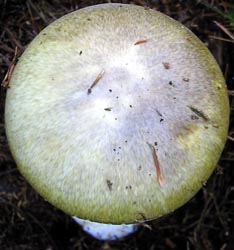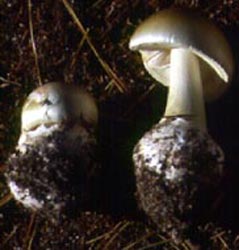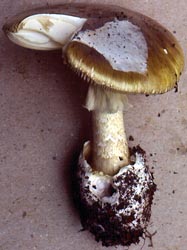[ Section Phalloideae page. ]
[ Amanita Studies home. ]
[ Keys & Checklist/Picturebooks ]
[ Australia/New Zealand List ]
[ New Jersey & region list ]
[ Subsaharan List ]
"Euro-Asian Death Cap"
= Amanita verna var. tarda Trimbach
= Amanita phalloides f. alba Britzelm. (= A. andaryi Mornand nom. inval.)




Technical description (t.b.d.)
BRIEF DESCRIPTION: The cap of Amanita phalloides is (40±) 65 - 152 (-300±) mm wide, with pigment arranged in narrow bands of variously colored spots giving the illusion of multicolored radially arranged imbedded fibers. Among the colors involved are pale to dark variance of olive-green, yellow green to yellow, gray, and brown. Often described as dark fibers on a greenish or yellowish ground color; however, this is an optical illusion. Sometimes the center of the cap may be entirely of the darkest tints while sometimes the center of the cap may appear bleached. The cap is often palest at the margin (for example white or extremely pale yellow or extremely pale yellow green). The cap is subovoid to hemispheric with incurved margin at first, becoming convex, eventually subplanar with decurved margin, smooth, wet and sticky when moist, shiny when dry, sometimes faintly pruinose particularly over the center, with a nonstriate and nonappendiculate margin. The volva is absent or occasionally present as membranous patch, white to sordid white to pale beige. The flesh is white except for a yellow line below the cap skin, however the yellow tint disappears with age, with such a line disappearing in age, unchanging when cut or bruised, 4.5- - 7.5+ mm thick over the stem, thinning evenly to margin.
The gills are free to narrowly adnate, crowded, white to cream in mass, white to cream to faintly pinkish cream to sordid cream to cream with slight yellow-greenish tinge in side view, unchanging when cut or bruised, 6 - 9 mm broad, with or without decurrent line on stipe apex. The short gills are truncate to excavate truncate to subtruncate, unevenly distributed, of diverse lengths, common, and occasionally arising at the stem as well as at the cap margin.
The stem is (35±) 54+ - 135 (-300±) × 8 - 17.5 (-20+) mm, largely white to pale yellow below the ring, sometimes more strongly yellow near the stem base, sometimes with faint yellowish white areas above the ring, narrowing upward, slightly flaring at the top in age, decorated with fine raised concolorous fibrils that darken from handling sometimes forming the "flame" pattern especially in the lowest third of stem. The bulb is 20 - 35+ × 16 - 50 mm, globose to subglobose, sometimes slightly compressed vertically, white, and very soft. The ring is in the upper part of the stem, membranous, up to 30± mm from the stem to its edge, white to pale yellow with fine radial striations on the upper side, somewhat felted and ranging from white to containing one or more of the cap colors (which may be in irregular patterns) on the under side. The limbate volva is white on outer surface, white to yellow or with other tints from the cap (sometimes similarly unevenly pigmented) on the inner surface, membranous, persistent, opening somewhat irregularly, with top of limb up 26- - 65 mm from the base of the bulb, with the limb more or less the same height as the bulb vertical thickness.
The odor is sometimes absent in early development, eventually sickeningly sweet or cloying like a "sweet ester."
The spores measure (7.5-) 8.0 - 10.1 (-13.5) x (5.5-) 6.1 - 8.0 (-10.5) µm and are subglobose to broadly ellipsoid to ellipsoid and amyloid. Clamps are not found at bases of basidia.
This species is deadly POISONOUS.
Amanita phalloides was originally described from Europe. In Europe in occurs with beech (Fagus), oak (Quercus), pine (Pinus), chestnut (Castanea), horse chestnut (Aesculus), birch (Betula), filbert and hazelnuts (Corylus maxima), iron wood or hornbeam (Carpinus), and spruce (Picea). In the northern hemisphere the present species when transplanted can spread to local trees of the same genera in addition to Canadian hemlock (Tsuga). It is reported under Leptospermum in New Zealand and under Eucalyptus and leguminous trees in Tanzania. Importation in the western hemisphere has occurred from Canada to Argentina.
This species is easily exported with its symbionts (oaks, pines, nut trees, etc.). As a consequence, it has been introduced in many countries in which European trees of its symbionts have been planted. It can then be exported from those countries it has colonized. It would appear that it and A. muscaria (L. : Fr.) Lam. subsp. muscaria have been the most commonly exported species of Amanita.
Everywhere it has been imported, it is a major cause of life-threatening mushroom poisonings. See also, A. arocheae Tulloss, Ovrebo & Halling, A. fuliginea Hongo, A. marmorata Cleland & E.-J. Gilbert, and A. subjunquillea S. Imai. The reader may want to examine the recently revised key to the taxa of sect. Phalloideae in North America.
The name Amanita phalloides f. alba Britzelm is often seen in the literature. The white specimens of A. phalloides usually occur among ones with normal coloration. The name probably has no taxonomic value. Historically, white specimens of A. phalloides appear to have caused some taxonomic and nomenclatural confusion because they were taken for specimens of A. verna (Bull. : Fr.) Lam. or another white species of sect. Phalloideae. In this regard, Neville and Poumarat (2004) treat Amanita verna var. tarda Trimbach and Amanita andaryi Mornand nom. inval. as synonyms of the white phalloides which they treat at varietal rank. Based on the available information, RET concur with their judgment. -- R. E. Tulloss and L. Possiel
Photos: R. E. Tulloss (New Jersey)
[ Section Phalloideae page. ]
[ Amanita Studies home. ]
[ Keys & Checklist/Picturebooks ]
[ Australia/New Zealand List ]
[ New Jersey & region list ]
[ Subsaharan List ]
Last change 5 August 2008.
This page is maintained by R. E. Tulloss.
Copyright 2003, 2004, 2005, 2006, 2008 by Rodham E. Tulloss.
Photographs copyright 2003 by Rodham E. Tulloss.